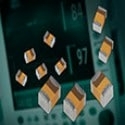source: AVX news
FOUNTAIN INN, S.C. (January 5, 2016) – AVX Corporation, a leading manufacturer of passive components and interconnect solutions, has introduced the new T4C Series HRC4000 medical grade, solid tantalum microchip capacitors. Designed for use in the filtering, hold-up, timing, and pulsing circuits within implantable, non-life-support and non-implantable life support applications, the T4C Microchip Medical Series delivers the smallest medical tantalum capacitors available in the industry (0402 case sizes) with low DC leakage levels (0.01CV or 0.3μA), in addition to change control for consistent supply and high standard reliability better than 0.1% failures per 1,000 hours, which is 10 times better than standard commercial reliability.
T4C Microchip Medical Series capacitors are manufactured and tested using AVX’s patented and extremely effective Q-Process technology, which was developed to replace the Weibull Reliability Assessment as the industry standard for tantalum capacitors due to its tendency to burn-in potentially unstable units. In use since 2013, the Q-Process effectively removes components that may experience parametric shifts through customer processing or display instability through life testing, ensures stable and normalized DCL distribution, and provides reliability level verification through life testing to a minimum of 0.1% per 1,000 hours with a 90% confidence level.
“Due to the critical nature of their successful operation, medical implantable, non-life-support and non-implantable life support applications demand electronic components capable of satisfying rigorous performance requirements, including exceptionally high reliability and low DCL,” said Brian Brunette, high reliability tantalum applications engineer, AVX. “
As the market leader in solid tantalum, medical grade components, our new T4C Microchip Medical Series capacitors deliver unparalleled quality at competitive prices, providing customers with high standard reliability and low DC leakage levels in the smallest medical tantalum case sizes available.”
T4C Microchip Medical Series capacitors are currently available in three case sizes (0402, 0603, and 0805), four rated voltages (4V, 6.3V, 10V, and 16V), and with two levels of statistical screening: T4C Standard for standard DCL and ESR limits, and T4C Custom for specific DCL and ESR parameter limits — down to 0.005CV on selected codes. Capacitance values for the series span 0.47μF to 22μF with a ±10% or ±20% capacitance tolerance, and rated operating temperatures range from 55°C to +125°C. Lead-free compatible and RoHS compliant, T4C Series capacitors are available with gold-plated or 100% tin terminations, and packaged in bulk or on 7” or 4.25” reels. Lead time for the series is 10–12 weeks.































